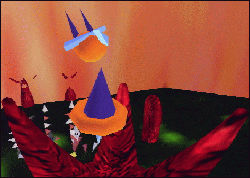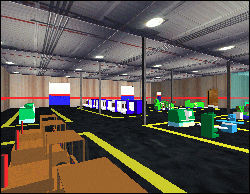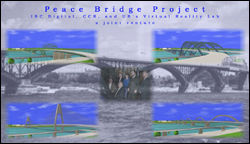CCR
is key resource for researchers
Super
computing center has helped attract $40 million in external funding
By ELLEN
GOLDBAUM
Contributing Editor
After completing
his post-doctoral work at Princeton University, Jeffrey Errington considered
returning to his native Western New York, but he figured the odds were
pretty much against him.
"My family
was telling me I should try and get a job in Buffalo," said Errington,
"but I told them the odds were pretty slim."
| |
 |
| |
"The
Thing Growing" is a virtual reality narrative in which the
user creates an interactive story and engages with the "Thing"
at an emotional level. |
| |
|
Like any
newly minted Ph.D. in the sciences, Errington viewed his job search
in purely national terms.
A graduate
of UB's School of Engineering and Applied Sciences who earned his doctorate
at Cornell University, Errington was seeking an institution with the
appropriate facilities for pursuing his research on the properties of
materials and chemical systems from a microscopic perspective. He writes
computer codes that model interactions between molecules in complex
fluids and biological systems to better understand their behavior. To
enact those simulations, he needs the power of supercomputers.
Coincidentally,
UB's Department of Chemical Engineering and the easy access to the university's
supercomputing facility—the Center for Computational Research, one of
the world's leading academic high-performance computing sites—offered
just what his research requires.
| |
 |
| |
"VR-Fact!"
is an interactive virtual factory development software that explores
the application of virtual environments in the area of manufacturing
automation. |
| |
|
"I was
very impressed with the facilities of CCR," he said. "I guess I was
surprised at the sheer magnitude of the complex."
Errington
also was impressed with the accessibility that faculty have to CCR,
regardless of their rank.
At Princeton,
he recalled, faculty and students have to pay what he called "a fairly
steep charge" to use its supercomputing facility.
"That's
not the case with CCR," said Errington. "One of the very nice things
about CCR, especially for new assistant professors who have very few
funds when they are starting out, is that there is this resource right
on campus that's completely available to faculty and completely free."
Errington
noted that supercom-puting facilities at some other schools also require
that faculty undergo an elaborate application process in order to use
the facility, and even if granted that privilege, use can be restricted;
CCR, on the other hand, is open to all faculty members who can prove
that their research requires supercomputers.
| |
 |
| |
CCR,
IBC Digital and UB's Virtual Reality Laboratory have developed an
interactive, 3-D computer animation of the leading Peace Bridge
proposals. |
| |
|
For more
and more new and existing faculty researchers at UB, having CCR on campus
is more than a perk; it is an increasingly critical resource that is
helping to propel major projects.
Supercomputing
has made major inroads in a broad range of projects at UB, helping to
garner about $40 million in external funding for UB faculty members.
As Errington's case proves, quite a few UB department heads have found
it's also playing a role in faculty recruitment.
Maurizio
Trevisan, professor and chair of the Department of Social and Preventive
Medicine and interim dean of the School of Health Related Professions,
discovered that this summer while recruiting for a biostatistician.
"The fact
that CCR is here was very important to me," he said. "Being able to
send candidates over there and have them talk with the center's staff
scientists really helped. Any institution that wants to be in the forefront
of research has to have something like CCR."
John Cowell,
chair of the cancer genetics department at Roswell Park Cancer Institute,
agrees. CCR, he noted, is becoming increasingly important as the bioinformatics
center in Western New York gains momentum. "It's definitely a plus,"
he said. "The disadvantage of having to go off-site is that supercomputing
centers in other regions can always bump you off their site because
on-site people have priority. Here, no one can log in over me."
Since opening
its doors in May 1999, CCR has been the source of an ever-expanding
group of enthusiastic supporters among faculty members, allowing them
to pursue new avenues in their work and making it possible to apply
for new grants that require easy access to supercomputing facilities
even to be considered.
The fact
that getting supercom-puting time at CCR is just that—relatively easy
in comparison with other, more established centers—as well as free,
also is a draw for new and current faculty members.
"Supercomputing
time is very accessible at CCR," explained Carl Lund, professor and
chair of the Department of Chemical Engineering.
At some
other institutions, he said, scientists may obtain an account, but then
have to wait weeks or even months before they actually can use the machines.
For Lund,
who conducts research on making more efficient use of catalysts used
by the chemical industry, having CCR available has meant being able
to develop new skills to advance his research.
"CCR has
provided me with the motivation to learn to do quantum chemistry," said
Lund. Calculations performed at CCR have helped Lund develop "virtual
catalysts" that guide the development of real catalysts once he is back
in the lab.
Some of
the most established users of CCR are in the area of bioinformatics,
including X-ray crystallography projects at UB and its affiliated institutions,
such as Hauptman Woodward Medical Research Institute, where senior research
scientist Charles Weeks uses CCR's massive computing power to solve
ever more complex molecular structures that are targets for new pharmaceuticals.
Yaoqi Zhou,
assistant professor in the Department of Physiology and Biophysics,
is uncovering the complexities of protein folding, using CCR to do theoretical
and simulation studies of protein folding, protein binding and protein-protein
interactions. The research covers the area of bioinformatics, structure-based
drug design, biophysics and computational biology.
Paras Prasad,
SUNY Distinguished Professor in the departments of Chemistry and Physics,
and executive director of the Institute for Lasers, Photonics and Biophotonics,
has used CCR's visualization resources to create a fully immersive,
three-dimensional image of a human cell based on two-dimensional slices
obtained using confocal microscopy.
While researchers
studying atoms and molecules have been some of the earliest users of
supercomputers, CCR's base of users is growing broader all the time.
Researchers
studying computational fluid dynamics also rely heavily on CCR's computing
resources. Cyrus Madnia and Peyman Givi, professors of mechanical and
aerospace engineering, use state-of the-art computer models developed
in their labs to study turbulent flow and combustion processes. The
goal of this research is to be able to design more efficient devices,
such as turbine engines and home furnaces.
Faculty
from disciplines not traditionally associated with supercomputing also
have begun to tap into CCR's facilities.
For example,
Josephine Anstey, visiting assistant professor in the Department of
Media Study, is an avid CCR user who relies on the center's visualization
capabilities to explore interactive, community-based virtual reality.
Anstey is working on a Japanese translation of her interactive, virtual
reality fiction, "The Thing Growing," for a show at a museum in Tokyo.
She also is using CCR's Internet 2 connectivity and high-end visualization
facilities to collaborate with the Electronic Visualization Laboratory
at the University of lllinois at Chicago on a networked virtual reality
art project. The project recently was shown at the Ars Electronica Festival
in Linz, Austria.
Another
non-traditional user is Samuel Paley, professor of classics, who is
collaborating with Thenkurussi Kesavadas, professor of mechanical and
aerospace engineering, and others to use CCR visualization facilities
to develop virtual tours of sites of archaeological interest, including
the palace of an ancient Assyrian king.
Scientists
from the Department of Civil, Structural and Environmental Engineering,
including Alan Rabideau, associate professor, and Igor Janckovic, assistant
professor, working with Matt Becker, assistant professor of geology,
and Doug Flewelling, assistant professor of geography, are developing
a computer model that can be used to predict the flow of contaminants
in groundwater. The project is funded by the Environmental Protection
Agency.
Local businesses
also have taken advantage of CCR, using super-computers in sectors ranging
from studying industrial gases to improving banking services to facility
planning and layout.
Community
outreach projects have included the visualization of models of various
options for a new or expanded Peace Bridge and plaza, and a virtual
reality walk-through of the 1901 Pan-American Exposition.
Most recently,
CCR has begun a collaboration with Philip Glick, professor of surgery
and obstetrics and gynecology and executive director of the Miniature
Access Surgery, Teaching, Training and Research Center, on a project
designed to bring virtual reality technology into the operating room
to assist in preoperative planning of complicated operations and in
training the next generation of surgeons in a safe and controlled environment.
Front
Page | Top Stories
| Briefly | Electronic
Highways
Mail | Q&A
| Sports | Exhibits,
Notices, Jobs
Events
| Current
Issue | Comments?
| Archives
Search
| UB
Home | UB
News Services | UB
Today



